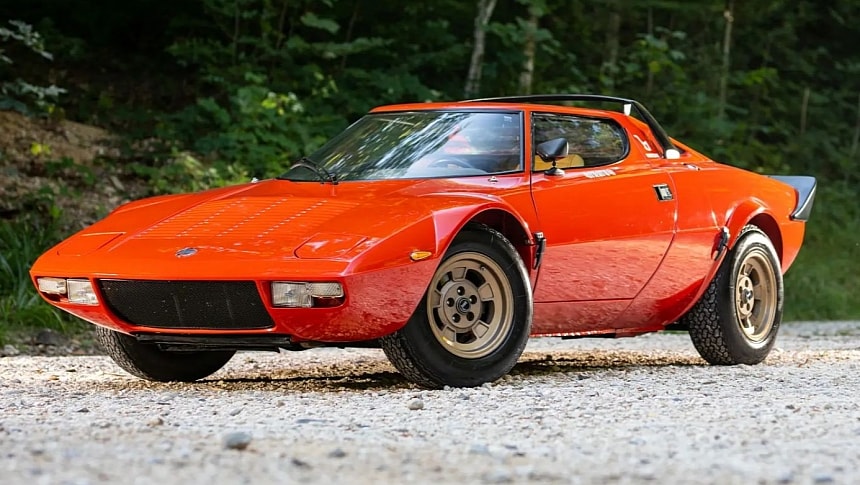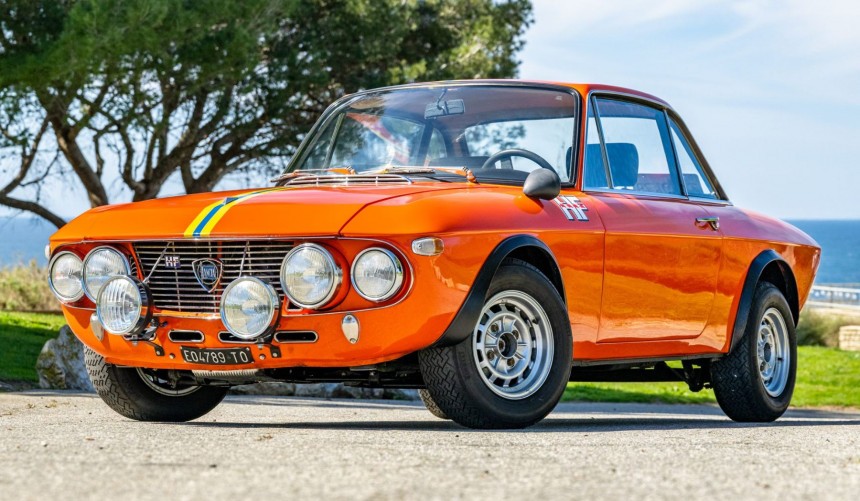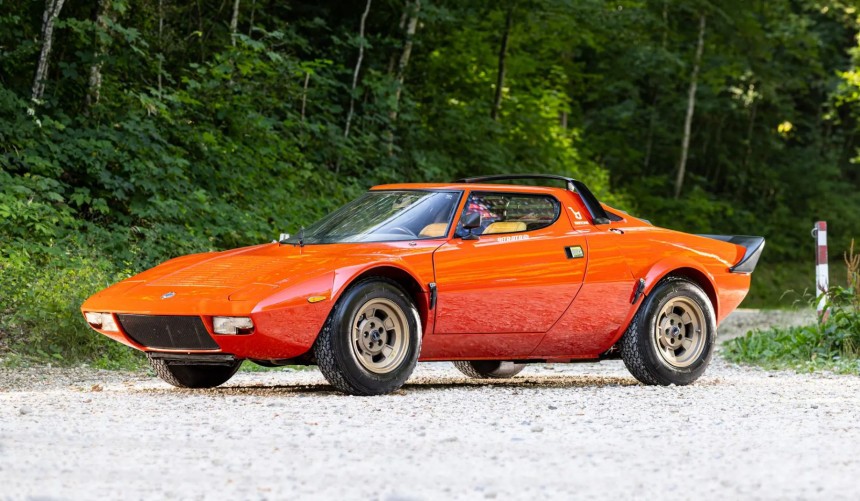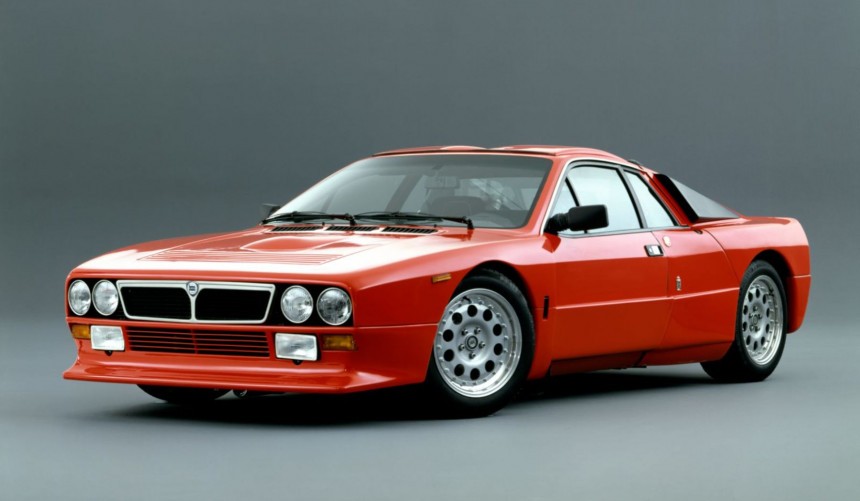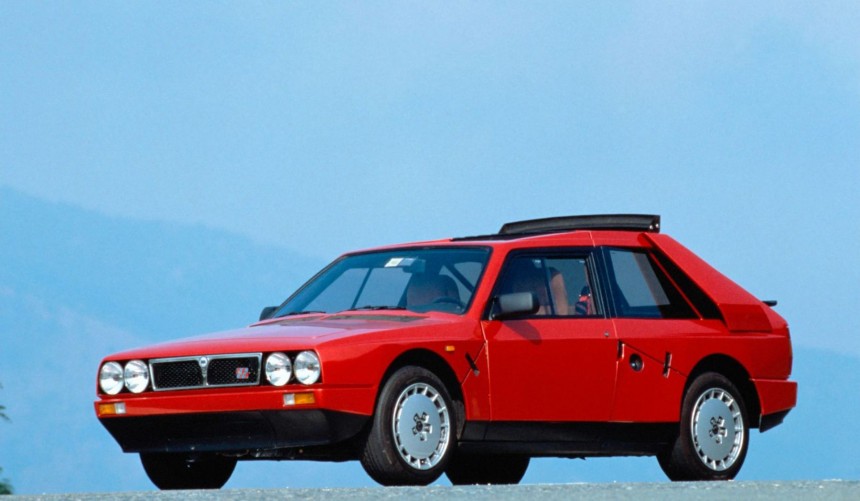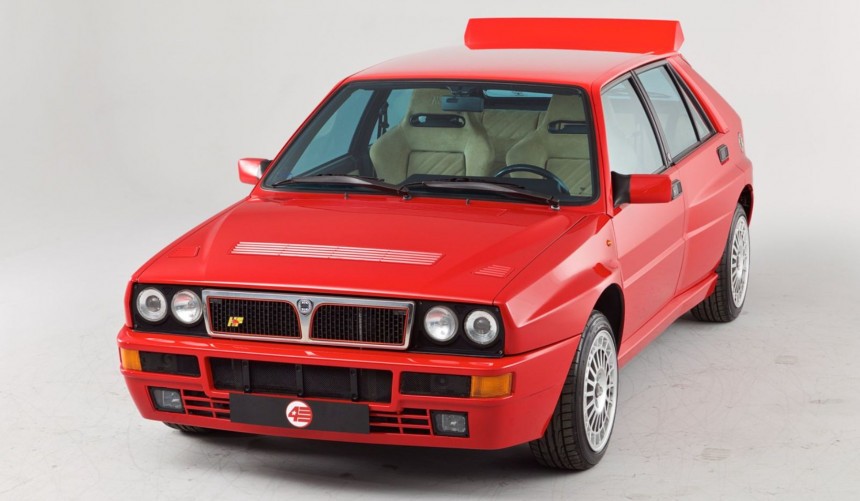Throughout its history, Lancia has been heavily involved in motorsport, which has led to some fantastic race cars and these five epic homologation specials.
Founded in 1906 by Fiat racing driver Vincenzo Lancia and his friend Claudio Fogolin, Lancia went on to become one of the most important carmakers in Italy.
Throughout its history, the company introduced several innovations, most notably, the first mass-produced V6 engine.
Purchased by Fiat in 1969 and currently part of the Stellantis corporation, Lancia has also been a big name in the motorsport world, having competed in Formula 1, sports car racing, and rallying throughout its history.
The company's greatest results came in rally competitions where Lancia won 15 titles in the European Rally Championship (ERC), as well as the WRC, where it remains the most successful manufacturer in competition history, with no less than 15 titles.
Lancia recently announced that it will return to rallying in 2025 with an ICE-powered version of its new, all-electric Ypsilon HF.
But while there's little chance that a street-legal version of the rally car will make it into production since the current rules are much different, during the golden age of rallying, when Lancia was extremely successful, homologation requirements meant it was forced to release limited-edition, road-legal versions of their rally cars.
So, without further ado, let's remember Lancia's greatest rally-bred homologation specials.
Launched in 1963, the Fulvia was dubbed "the small sister" of the larger Flavia, and although it didn't look like much, it was an engineering masterclass.
Initially available as a four-door sedan, the new model was powered by the last, most advanced series of Lancia's narrow-angle V4, an aluminum DOHC engine with multiple displacement versions.
Moreover, it featured an FWD configuration and four-wheel disc brakes during an era when many carmakers were still using drums behind all four wheels of their production models.
Two years after the debut of the four-door sedan, a sportier two-door coupe version was introduced, and it shortly became the go-to model for Lancia's factory-backed effort in the world of rallying.
Arguably, the most impressive Fulvia coupe was launched in 1969 as the Rallye 1.6 HF, the street-legal version of the company's new rally weapon and an evolution of the previous Rallye 1.3 HF.
Nicknamed "Fanalone" (or "Fanalona"), meaning "big headlamps," the performance-oriented Fulvia was powered by an all-new 1.6-liter version of the V4 rated at 113 hp.
Additionally, it had a thoroughly improved suspension geometry, several aluminum body panels to reduce weight, wider wheel arches to accommodate the wider alloy wheels, and a close-ratio five-speed manual transmission.
To this day, the Fulvia Rallye 1.6 HF is one of the most iconic cars ever made by Lancia, as it laid the groundwork for the manufacturer's dominance in the rally world.
During the early 1970s, Lancia decided to replace the Fulvia HF with a new rally weapon, which led to aruably the wildest production car that ever donned the company's badges.
Dubbed Stratos HF Stradale and based on the futuristic Bertone concept called Stratos Zero (1970), the all-new model went into production in 1973.
With an eye-catching, wedge-shaped fiberglass body, the Stratos was more aerodynamically efficient than any Lancia produced before.
It was built around a bespoke space frame chassis and featured a mid-mounted engine sourced from fellow Fiat stablemates Ferrari.
The powerplant in question was the 2.4-liter Dino V6, which made 190 hp in street-legal form. However, in the rally-spec cars, the Dino was tuned to produce up to 320 hp, making the 1,940-pound (880 kg) Stratos, with its near-flawlessly tuned suspension and steering, virtually unbeatable.
Consequently, the Stratos helped Lancia win three consecutive WRC titles during the 1970s, the iconic Targa Florio race in 1974, and five trophies in the Tour de France Automobile.
The Stratos was retired in 1978, but Lancia was not done dominating the rally world, so its engineers, with help from tuning experts Abarth, developed another epic car.
Officially called Rally, but known by its codename 037, the Group B contender was launched in 1982.
Though it was built with the sole purpouse of dominating the WRC, the had to be converted to a street-legal vehicle to gain homologation, so that year, the Stradale (Street) version was also launched.
Like the rally car, the Stradale featured an entirely bespoke chassis and a high-tech carbon-kevlar body.
It was powered by a mid-mounted, supercharged DOHC straight-four developed by Abarth. Mated to a ZF 5-speed manual, it was limited to 205 hp in road-legal spec, which was enough to propel the 2,579-pound (1,170 kg) Stradale from 0 to 62 mph (100 kph) in 5.8 seconds.
The Rally 037 Stradale was produced in 207 examples from 1982 to 1984. In rally guise, it wasn't as successful as its predecessor, as the Group B was turning to 4WD, but it still helped Lancia grab the 1983 WRC manufacturer title.
With Audi and Peugeot proving that 4WD was the wave of the future in rallying, Lancia and engineering partners Abarth got back to the drawing board in 1984 and developed a new challenger.
Though it loosely resembled the mass-produced Delta and shared its name for marketing purposes, the S4 was an entirely new design.
Like its predecessor, it featured a tubular steel space frame chassis, but unlike the Rally, it was equipped with a triple-differential 4WD system developed by British experts Hewland, who also developed the five-speed transmission.
In the middle of the chassis, the S4 hid one of the most advanced four-cylinders ever built, a highly modified Fiat Twin Cam dubbed Tipo 233 ATR 18S.
Equipped with a forced induction system that used a turbo and a supercharger, the innovative engines could produce up to 1,000 hp with the boost pressure turned up to 5 bar (72 PSI).
However, in the road-legal Stradale, output was limited to 247 hp. Apart from that, and the 30/70 distribution of the 4WD system, the Stradale was identical to the race-spec version which was dubbed one of the most dangerous and outrageous rally cars ever built.
The first-generation Delta, a five-door hatchback, was launched in 1979 and, with slight improvements, remained in production until 1994.
After the Group B era came to an abrupt end and the S4 - which had nothing but the name in common with the Delta - was rendered obsolete, Lancia transformed the mass-produced Delta into its main rally weapon.
It all started with the Delta HF, the first homologation special based on the production hatchback, which debuted in the summer of 1983 and was continualy developed until 1993.
The Delta HF line became Lancia's most successful rally car, racking up six consecutive WRC constructors' championships and four drivers' titles.
Of the multitude of Delta homologation specials developed during those successful nine years, the last was also the most impressive.
Unveiled in 1993, the ultimate Delta HF Integrale, dubbed Evoluzione II featured a bespoke body kit, Recaro bucket seats, a refined 4WD system, and, last but not least, an updated version of the 2.0-liter16-valve turbo engine that made 212 hp.
With a lightweight construction, near flawless suspension geometry, and more than adequate power, the Delta Evo II continues to be the ultimate hot hatch for many enthusiasts - myself included.
Throughout its history, the company introduced several innovations, most notably, the first mass-produced V6 engine.
Purchased by Fiat in 1969 and currently part of the Stellantis corporation, Lancia has also been a big name in the motorsport world, having competed in Formula 1, sports car racing, and rallying throughout its history.
The company's greatest results came in rally competitions where Lancia won 15 titles in the European Rally Championship (ERC), as well as the WRC, where it remains the most successful manufacturer in competition history, with no less than 15 titles.
Lancia recently announced that it will return to rallying in 2025 with an ICE-powered version of its new, all-electric Ypsilon HF.
But while there's little chance that a street-legal version of the rally car will make it into production since the current rules are much different, during the golden age of rallying, when Lancia was extremely successful, homologation requirements meant it was forced to release limited-edition, road-legal versions of their rally cars.
So, without further ado, let's remember Lancia's greatest rally-bred homologation specials.
Lancia Fulvia Rallye 1.6 HF
Initially available as a four-door sedan, the new model was powered by the last, most advanced series of Lancia's narrow-angle V4, an aluminum DOHC engine with multiple displacement versions.
Moreover, it featured an FWD configuration and four-wheel disc brakes during an era when many carmakers were still using drums behind all four wheels of their production models.
Two years after the debut of the four-door sedan, a sportier two-door coupe version was introduced, and it shortly became the go-to model for Lancia's factory-backed effort in the world of rallying.
Arguably, the most impressive Fulvia coupe was launched in 1969 as the Rallye 1.6 HF, the street-legal version of the company's new rally weapon and an evolution of the previous Rallye 1.3 HF.
Nicknamed "Fanalone" (or "Fanalona"), meaning "big headlamps," the performance-oriented Fulvia was powered by an all-new 1.6-liter version of the V4 rated at 113 hp.
Additionally, it had a thoroughly improved suspension geometry, several aluminum body panels to reduce weight, wider wheel arches to accommodate the wider alloy wheels, and a close-ratio five-speed manual transmission.
To this day, the Fulvia Rallye 1.6 HF is one of the most iconic cars ever made by Lancia, as it laid the groundwork for the manufacturer's dominance in the rally world.
Lancia Stratos HF Stradale
Dubbed Stratos HF Stradale and based on the futuristic Bertone concept called Stratos Zero (1970), the all-new model went into production in 1973.
With an eye-catching, wedge-shaped fiberglass body, the Stratos was more aerodynamically efficient than any Lancia produced before.
It was built around a bespoke space frame chassis and featured a mid-mounted engine sourced from fellow Fiat stablemates Ferrari.
The powerplant in question was the 2.4-liter Dino V6, which made 190 hp in street-legal form. However, in the rally-spec cars, the Dino was tuned to produce up to 320 hp, making the 1,940-pound (880 kg) Stratos, with its near-flawlessly tuned suspension and steering, virtually unbeatable.
Consequently, the Stratos helped Lancia win three consecutive WRC titles during the 1970s, the iconic Targa Florio race in 1974, and five trophies in the Tour de France Automobile.
Lancia Rally 037 Stradale
Officially called Rally, but known by its codename 037, the Group B contender was launched in 1982.
Though it was built with the sole purpouse of dominating the WRC, the had to be converted to a street-legal vehicle to gain homologation, so that year, the Stradale (Street) version was also launched.
Like the rally car, the Stradale featured an entirely bespoke chassis and a high-tech carbon-kevlar body.
It was powered by a mid-mounted, supercharged DOHC straight-four developed by Abarth. Mated to a ZF 5-speed manual, it was limited to 205 hp in road-legal spec, which was enough to propel the 2,579-pound (1,170 kg) Stradale from 0 to 62 mph (100 kph) in 5.8 seconds.
The Rally 037 Stradale was produced in 207 examples from 1982 to 1984. In rally guise, it wasn't as successful as its predecessor, as the Group B was turning to 4WD, but it still helped Lancia grab the 1983 WRC manufacturer title.
Lancia Delta S4
Though it loosely resembled the mass-produced Delta and shared its name for marketing purposes, the S4 was an entirely new design.
Like its predecessor, it featured a tubular steel space frame chassis, but unlike the Rally, it was equipped with a triple-differential 4WD system developed by British experts Hewland, who also developed the five-speed transmission.
In the middle of the chassis, the S4 hid one of the most advanced four-cylinders ever built, a highly modified Fiat Twin Cam dubbed Tipo 233 ATR 18S.
Equipped with a forced induction system that used a turbo and a supercharger, the innovative engines could produce up to 1,000 hp with the boost pressure turned up to 5 bar (72 PSI).
However, in the road-legal Stradale, output was limited to 247 hp. Apart from that, and the 30/70 distribution of the 4WD system, the Stradale was identical to the race-spec version which was dubbed one of the most dangerous and outrageous rally cars ever built.
Lancia Delta HF integrale Evoluzione II
After the Group B era came to an abrupt end and the S4 - which had nothing but the name in common with the Delta - was rendered obsolete, Lancia transformed the mass-produced Delta into its main rally weapon.
It all started with the Delta HF, the first homologation special based on the production hatchback, which debuted in the summer of 1983 and was continualy developed until 1993.
The Delta HF line became Lancia's most successful rally car, racking up six consecutive WRC constructors' championships and four drivers' titles.
Of the multitude of Delta homologation specials developed during those successful nine years, the last was also the most impressive.
Unveiled in 1993, the ultimate Delta HF Integrale, dubbed Evoluzione II featured a bespoke body kit, Recaro bucket seats, a refined 4WD system, and, last but not least, an updated version of the 2.0-liter16-valve turbo engine that made 212 hp.
With a lightweight construction, near flawless suspension geometry, and more than adequate power, the Delta Evo II continues to be the ultimate hot hatch for many enthusiasts - myself included.
